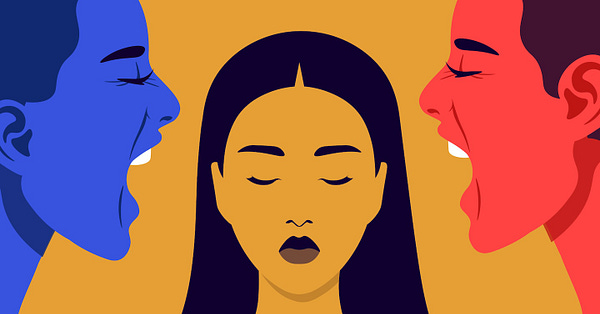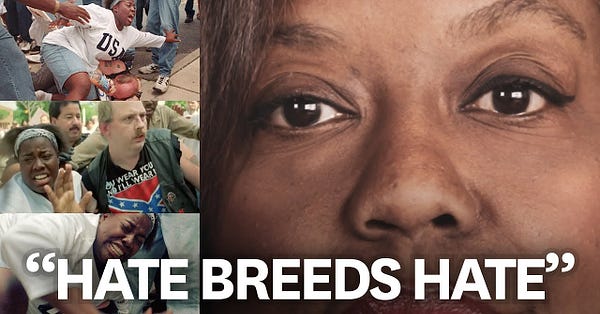E-Pluribus | April 4, 2023
Shut up, the students explained; one man's conspiracy theory is another man's facts; and art should speak for itself.
A round-up of the latest and best writing and musings on the rise of illiberalism in the public discourse:
Tess Winston: With Some of My Fellow Stanford Law Students, There’s No Room for Argument
By their very natures, extremes tend to get the attention. When it comes to an academic setting, Stanford Law student Tess Winston writes at the Washington Post that this tendency leaves a lot of people out. Winston does not necessarily think we should “just all get along,” but we should at least all listen.
But as a third-year student at Stanford Law School, I see a more troubling problem: an academic environment with two loud camps, one aligning with far-right politics, one aligning with the far left. In between, where most students can be found: silence.
There’s little room for nuance. If you’re not overtly one of “us,” then you’re assumed to be one of “them.”
The far-right students make up a small and unpopular camp; there are perhaps half a dozen in my third-year class of 180 students. But their words and actions — such as trying to block the graduation of a progressive student who had mocked the conservative Federalist Society and its Stanford chapter’s invitations to speakers seemingly with the aim of provoking — have an outsize effect.
The far-left students in my class are more numerous — perhaps 20. (The left/right balance is closer in the classes behind me.) They are also far more outspoken than those on the right. And they hold more social influence because, in my experience, the many law students with left-of-center politics, but not far left, fear being labeled moderate or conservative by them.
The far-left students have a dismissive shorthand for fellow students whose politics they consider not sufficiently progressive: “future prosecutors.” The message is loud and clear — prosecutors are the bad guys. But also: Be careful what you say.
I often think of one of my first-year professors, who was appalled by these students’ stigmatizing of the prosecutorial role. He asked one: Given that prosecutors decide whether and what charges to bring against a defendant, isn’t it preferable for well-qualified people to fill the role? Without missing a beat, the student responded: No, being a prosecutor is simply evil.
Read it all here.
Christopher J. Snowdon: The Rise of the Respectable Conspiracy Theory
Everybody loves a good conspiracy theory! OK, well maybe not everybody, but at Quillette, Christopher Snowdon writes that the inclination towards believing such theories is fairly evenly spread across the ideological spectrum. The problem is that we all tend to believe what we want to believe.
In the same article in which he lambasts Brand, Monbiot asserts that “Almost all successful conspiracy theories originate with or land with the far right.” But this simply isn’t true. An interesting study published last year concluded that neither the Left nor the Right are systematically biased towards conspiracy theories. Based on 20 surveys conducted in the US between 2012 and 2021, the authors found that around a third of the conspiracy theories they reviewed were more attractive to Republicans than to Democrats, a third were more attractive to Democrats than to Republicans, and the rest were non-partisan. Right-wingers were particularly susceptible to conspiracy theories about COVID-19 while left-wingers were drawn to conspiracy theories about Donald Trump. Right-wingers tended to be more anti-vax when it came to COVID-19 but not when it came to MMR. Republicans were more likely to believe that global warming is a hoax and the Sandy Hook massacre was faked while Democrats were more likely to believe that the Moon landings were faked and that OJ Simpson was framed.
[ . . . ]
Some of the best-known conspiracy theories, including the JFK assassination, Holocaust denial, and 9/11 being an “inside job,” were not associated with political views, although they may have been in the past. The authors make the important observation that widely believed conspiracy theories sometimes start out on the Left or Right and become bipartisan over time. Neither the 9/11 “truth” movement nor the JFK conspiracy originated on the far-Right. On the contrary, they most appealed to people who hated George W. Bush and couldn’t face the reality of Kennedy being murdered by a Marxist, respectively.
Not unpredictably, comments about this study on social media took two forms. There were those who insisted that some of the theories reviewed should not have been included because they were true and there were those who accused the researchers of not including conspiracy theories they associated with their political opponents. The problem is nobody believes that their own crackpot theories for how the world works are conspiracy theories. If they did, they would stop believing them. Conspiracy theories are for other people—gullible people who belong to the outgroup. They are conspiracy theorists. We are free thinkers who do our own research and think critically.
Read the whole piece.
Angel Eduardo: Why ‘Sensitivity Readers’ Are Bad for Free Speech, Art, and Culture
“I can’t define what makes good art and literature, but I know it when I see it.” This is how many would characterize what art is worthwhile, what isn’t and possibly what should be outright rejected. Angel Eduardo of the Foundation for Individual Rights & Expression says that the problem with this attitude is that beauty (as well as ugly, offensive, inauthentic, etc.) is in the eye of the beholder.
Unlike, say, medical or scientific consultants, who tend to be scholars in their field and possess a breadth of academic knowledge, sensitivity readers either claim or are assumed to have expertise on what words, ideas, or language cause offense — which is hardly an academic pursuit.
This raises a number of questions: How can any given reader know what you or I might find offensive? Whose “sensitivities” are really being considered, and how are they determined? What if the preferences of two different groups, or of various people within a group, are in conflict? Who determines whose offense takes priority? What about those who are offended by the edits themselves?
[ . . . ]
Another issue is that sensitivity readers (and their close cousins, “authenticity readers”) are also purported to be experts on what constitutes the genuine “lived experience” of characters from minority or marginalized backgrounds. But how can that be true? Who decides what experiences, behaviors, and manners of speaking are “authentic” to any particular group? How can this be decided without veering into subjectivity, solipsism, racism, stereotyping, and essentialism?
Read it all.
Around Twitter
Safe spaces? Van Jones isn’t having any of it in this flashback to 2017, via the Foundation for Individual Rights & Expression:

Emma Camp of Reason on the potential danger of “ideological purity” with a personal example to back it up:




And finally, one person really can make a difference:








